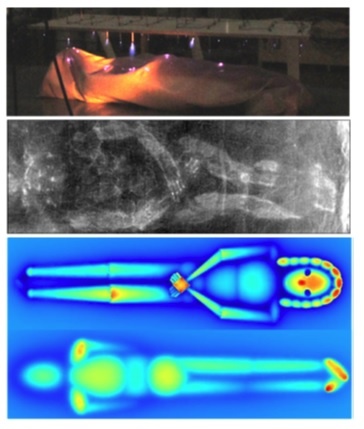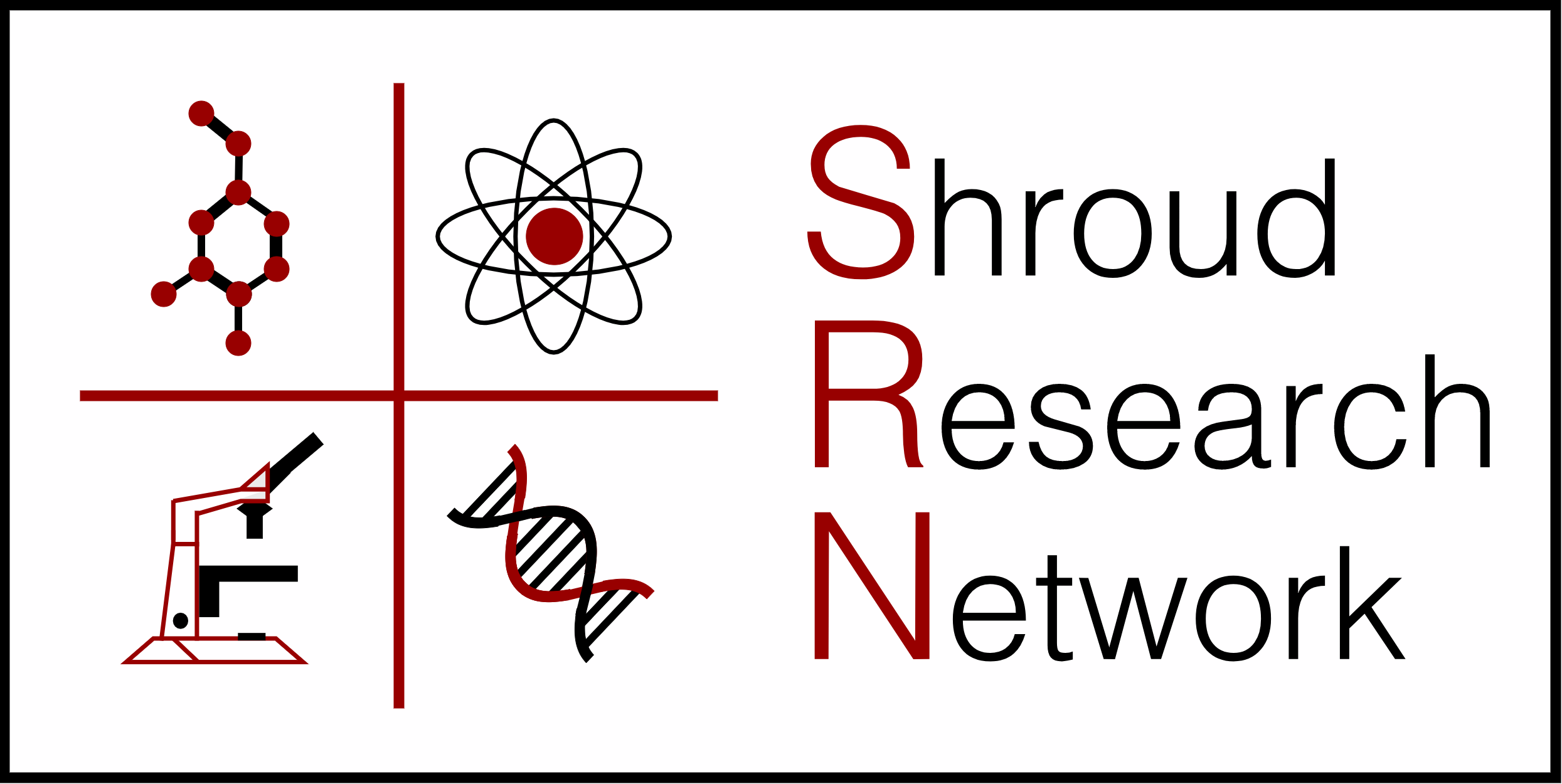ABSTRACTS - CONFERENCE-2017
This page is under construction. 1/26/2018 JCP
1. “Overview of the Shroud” by Robert Siefker.
The presentation is a Critical Summary of observations, data and hypotheses related to the Shroud of Turin covering Historical Evidence, Medical Forensic Evidence, Linen Cloth Evidence, Image Characteristic Evidence, and includes a review and evaluation of the major Image Formation Hypotheses that have been proposed over the last 100 years. The presentation is based on a publication of the Turin Shroud Center of Colorado (TSC) that is headed by John Jackson (PhD in physics) who headed the landmark Shroud of Turin Research Project (STURP). The TSC publication is entitled “The Shroud of Turin: A Critical Summary of Observations, Data, and Hypotheses” which includes many pieces of data that trace their source back to the research conducted by the STURP team, as well as data from the broad spectrum of other scientific and historic research that has been conducted on the Shroud, both before and after the STURP expedition.
2. “CSI Jerusalem, Case of the Missing Body” by Russ Breault.
A full documentation of the scientific evidence and the historical trail that supports the probable authenticity. Plus, a complete analysis of the Shroud as it relates to Scripture—a detailed depiction of the crucifixion ordeal, analysis of what may have happened in the tomb and an exploration of the post-resurrection body concluding with a study of Doubting Thomas and how his story relates to the Shroud. Appealing to both mind and heart, it is a compelling and inspiring presentation. 90 Minutes.
3. “The Crown of Thorns: The Paradoxical Lordship of the King of Kings” by Andrew Dalton.
Following a description of the wounded head in the light of natural reason, I turn to the Biblical witness to explore the theological meaning of the crown of thorns. In short, we will see that: 1) Thorns first appear as a punishment for Adam’s sin (cf. Gen 3:18). 2) For Jesus, thorns are a metaphor for moral evil (cf. Matt 7:16f). 3) Thorns enter into the typological relationship between Isaac’s sacrifice and the death of Christ (cf. Gen 22). In Jesus, God provides the Passover Lamb, who takes away the sins of the world (cf. John 1:29; 1 Cor 5:7). Finally, deep irony lies behind the mock worship, “Hail, King of the Jews” (Matt 27:29): whereas worldly despots lord it over their subjects (cf. Mt 20:25), this good shepherd lays down his life to save his lost sheep (cf. John 10:11). Christ is an upside-down king in a paradoxical kingdom. Appropriately, he wears a crown of thorns.
4. “Exposition of John 20” by Fred Baltz, read by Massimo Paris
This presentation looks at the description of Jesus’ tomb as seen by Peter, and the Beloved Disciple (John 20) in light of Gospel themes, special vocabulary, the internal unity of the Gospel, and the revelatory message inherent in the scene as described. Its proposal for the proper translation of verse 7 differs from what one finds in standard Bible translations, because translators do not take these other matters into account. Scholar/commentators do, and reach different conclusions from translators at times. So, we propose: “He (Simon) observed the linen cloths lying, and the Sudarium, which had been upon his head, not lying with the burial cloths, but separate from view where it was at first.” In other words, the Sudarium was still within the shroud. No other way of understanding verse 7 can stand. What Peter observed was the outline of the Sudarium, repurposed as a chin band. This should be the starting point for evaluating whether the Shroud of Turin and the Sudarium of Oviedo comport with the biblical evidence.
5. “The Role of Epistemology in Approaching Truth in the Shroud of Turin” by Cheryl White.
From the time of the ancient Greek philosophers through the Age of Enlightenment and the Scientific Revolution, man has presumed the existence of universal truth as something that is accessible and knowable. From the Platonic Doctrine of Forms that established the foundations of what would become a faith-based epistemology seeking ideal and perfect forms, to the Aristotelian universe of the Unmoved Mover using an epistemology of observation and external proofs found in nature, philosophy has progressed to incorporate each of these as means by which man comes to understand all aspects of life and his existence. Throughout late Classical Antiquity and into the High Middles Ages, philosophers such as St. Augustine and St. Thomas Aquinas assured that each of these epistemologies found further expression in western Christian thought. The Neo-Platonist St. Augustine and the Aristotelian St. Thomas Aquinas gave credibility to each of these approaches to knowledge, in a way that has continued to inform and influence man’s quest for truth. Over the centuries that have passed since the first mention of the Shroud of Turin in the documented historical record, these epistemologies have largely not been in competition for understanding this relic. The reason for this is found in the nature of the Shroud itself, which continues to reveal new information about itself as new and more sophisticated methods of science have developed. Until the late nineteenth century, those who venerated the cloth did so without knowing the fullness of the photographic image imprinted there, meaning they venerated from a standpoint of faith what they received to be truth, with no further external evidence. Following the exposure of the full image on the cloth, the epistemology applied to Shroud studies has shifted to one of science and empiricism, as it became obvious through observation that the Shroud was much more than a simple medieval forgery or odd artifact. Inquiry and ongoing exploration of the Shroud of Turin must be approached with respect for each epistemology, given their historical association with both man’s quest for knowledge and this specific relic itself. To date, each philosophical construct unnecessarily suffers from a suspicion of the other, and yet each falls short in answering the seemingly unanswerable. Through a historical and philosophical analysis of the ways in which man has approached this unusual and unique cloth, this paper will explore the implications of advancing both epistemologies for future study and progress toward truth.
10. “Geoffrey de Charny’s Acquisition of the Shroud of Turin: Texts, Fictions, and Forgeries” by Jack Markwardt.
In approximately 1355-1356, the Shroud of Turin was publicly exhibited in the small French village of Lirey. The manner in which its then-owner, Geoffrey de Charny, an esteemed knight, acquired the relic has remained unknown for more than six and a half centuries. Over the course of the last one hundred and fifteen years, various hypotheses have attempted to explain Geoffrey’s ownership of the relic, each of which proceeds upon the assumption that the Turin Shroud was the imaged sindon which, in 1203 and 1204, was publicly exhibited in Constantinople. This paper will analyze the fifteen most prominent of these theories and the historical texts, the historical fictions, and the historical forgeries upon which each of these narratives is based. It will examine the various proposed chains of ownership which run from the Byzantine emperor to Geoffrey de Charny, assess the plausibility of their component links, and review the multiple factors which determine whether such theories should be, or should not be, considered convincing.
16. “Avignon and the Shroud of Turin: Authenticity Confirmed” by Jack Markwardt.
The circumstances which surround the fourteenth-century exhibitions of the Shroud in the small French hamlet of Lirey continue to confound historians. The initial expositions go unreferenced in Vatican archives and appear to have proceeded without papal approval. With regard to the later expositions, the sanctioning Pope concealed his reasons for allowing them to take place, silenced a bishop who alleged the relic’s fraudulence, and issued three inconsistent bulls regarding how the cloth was to be described when exhibited. In addition, both the relic’s owners and the Church never publicly disclosed its provenance. This paper will resolve all of the mysteries which surround the Lirey exhibitions and demonstrate that, before they were permitted to commence, the Church determined that the Shroud of Turin was an authentic relic of Jesus Christ. For five centuries thereafter, the Vatican referred to the Shroud as Jesus’ actual burial cloth; however, for reasons which this paper will reveal, the Church now alludes to the relic as an icon, or image.
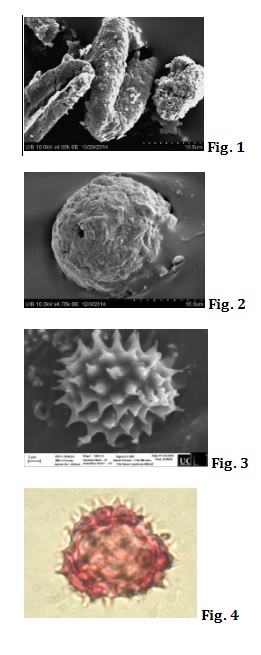
23. “Numismatic dating of the Turin Shroud through the analysis of Byzantine coins” by Giulio Fanti.
The 1988 radiocarbon dating of the Turin Shroud (TS) assigned a calibrated calendar age of 1260-1390 A.D. with a 95% confidence for the linen fabric, but three recent alternative dating methods assigned an age compatible with the First Century A.D., the period in which Jesus Christ lived in Palestine. The present analysis is based on the face and on the posture of Christ reported on many Byzantine coins that clearly demonstrate that the TS was seen starting from 692 A.D., the year in which the emperor Justinian II represented the face of Christ on the coins for the first time in the history. It is interesting to observe that, as not all the peculiar details of the TS face were represented in such a small depiction of a coin, the choice of which detail had to be considered was let to the single engraver. Therefore, we can see coins made by different officials, under the same emperor, showing different details, all typical of the TS face, but with different faces of Christ. With the time passing, not all the engravers had the possibility to observe directly the TS; as a result, a degradation of the similarity with the TS of the produced face of Christ results. Nevertheless, when the TS was taken to Constantinople in 944 A.D., we detect a great improvement of the partially lost similarity. This is also demonstrated by an analysis based on the variation of the ratio between eyes distance and nose length. From a probabilistic analysis, it results that the Byzantine engraver who represented Christ on the gold solidus, semissis, tremissis and silver hexagram during the period of Justinian II would have only seven chances in one billion of billions of different possibilities of hitting these peculiar features all together without having seen the TS; this demonstrates that the TS was seen in the first Millennium A.D. The paper also presents a tracking shot of the various features, different century by century, but all in agreement with the TS body image, reported in the Byzantine coins up to the fall of the Byzantine Empire in 1204 A.D. and in the following centuries, evidencing the various features of the TS image frequently reproduced in accordance with Byzantine canons.

The following figure shows two wrapping configurations of the face of the life-size sculpture representing the Shroud Man with a high-contrast copy of the Shroud. Folds are evident in the mouth-beard area and on the forehead.
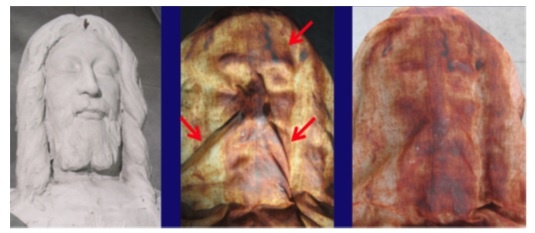
After the superimposition of two scans of the face and the cloth, the resulting face-cloth distance is less than 1 cm from Shroud image; folds result in correspondence of the left forehead and near the right mouth-beard area just where M. Azevedo and P. Soons found deep hollows. Also a numerical result confirms the presence of folds near the mouth-beard area. These results are in favor of the hypothesis of a tight wrapping of the TS with an image-extinction-distance less than one cm.
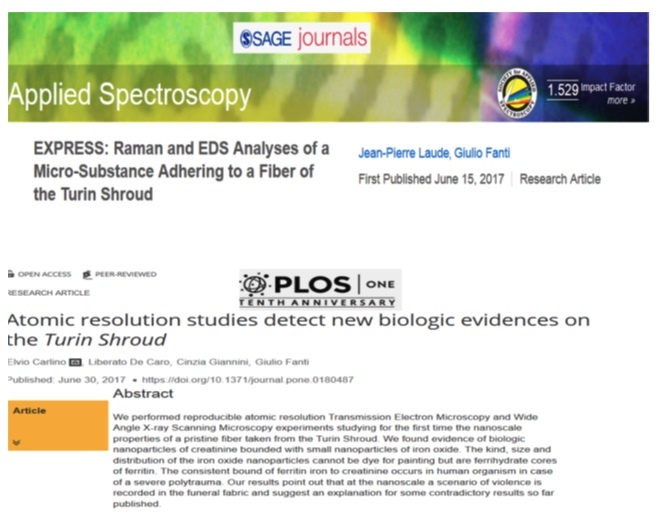
32. Panel Discussion on Science and Dating
Sitting left to right: Robert Siefker, Mark Antonacci, Joe Marino, Bob Rucker, and Janis Winchester, with Cesar Barta standing to the left for one question.
In this presentation we will detail two unpublished results that test both hypotheses, to some extent. In the first experiment we have irradiated fresh human bloodstains on linen by UV laser pulses having the same intensity and laser parameters that allow a Shroud-like coloration of linen. The blood had very high endogenous bilirubin level, about 8 times larger than the normal range. We have measured the RGB values of bloodstains immediately before and after UV irradiation, and 30 months after irradiation, to check long term effects, if any. In the second study we have found tiny spectroscopic clues comparing the reflectance spectrum of the blood on the TS measured by Soardo et al. with the absolute reflectance spectrum of the marks simulating blood on the Shroud of Arquata, a 1:1 copy of the TS dated back to 1653 AD. The comparative analysis has been extended to the spectral reflectance measurements performed in 2015 just before the Shroud exhibition.
 http://www.lastampa.it/2011/12/12/vaticaninsider/eng/inquiries-and-interviews/the-shroud-is-not-a-fake-jdiKKEyJ0uDsE4XpV13TcK/pagina.html
http://www.lastampa.it/2011/12/12/vaticaninsider/eng/inquiries-and-interviews/the-shroud-is-not-a-fake-jdiKKEyJ0uDsE4XpV13TcK/pagina.html  http://news.nationalgeographic.com/2015/04/150417-shroud-turin-relics-jesus-catholic-church-religion-science/
http://news.nationalgeographic.com/2015/04/150417-shroud-turin-relics-jesus-catholic-church-religion-science/ 43. “Image Formation by Corona Discharge” by Giulio Fanti.
Many hypotheses have been carried out on linen fabrics to explain the formation of the body image, but for the moment no solution has been found. In 1983, Osvald Scheuermann proposed a possible body image formation mechanism based on Corona Discharge (CD), followed by I. Bensen(1984), R. Morgan and G. Coote (1985), J.B. Judica Cordiglia (1986), E. Lindner (1997), F. Lattarulo (1998), A. Adler (1999), G. De Liso 2000, G. Fanti (2005) and others. A CD is an electrical discharge brought on by the ionization of a fluid. A current develops between two high-voltage electrodes in a dielectric fluid, usually air, by ionizing the fluid so as to generate a plasma around one electrode. The generated ions are used as charge carriers to the other electrode. An atom is ionized if it is subject to a strong electric field: it generates a positive ion and an electron. A TS-like image has been obtained by using CD in a proper set-up at Padua University and a half-life conductive manikin. Although electrons are the medium that triggers the process, it is the UV light and heating that produce the image: they react with the linen fibers, and break their C=C chemical compounds. There are many evidence in favor of a CD hypothesis of image formation. Among them the image has striations along the linen yarn. This is not simple to explain if any radiation composed of uniformly distributed photons is hypothesized. Like the Shroud, CD causes a doubly-superficial, negative and 3-D body image. The color corresponds to a dehydratation and oxydation of polysaccharides, as detected on the TS image. Experimental tests allowed to obtain an image after 24 hours of CD and ironing for 60 s at a 180 ±15 °C and numerical results confirmed the possibility to obtain body images quite similar to that of the Shroud (see figures). Theoretical and numerical results are in favor of the hypothesis of TS body image formation by CD. At microscopic level, the CD image is similar the Shroud. Similarities at macroscopic level are also: negative type, 3D features and resolution. The experimentally detected distortion must be studied in the future.
